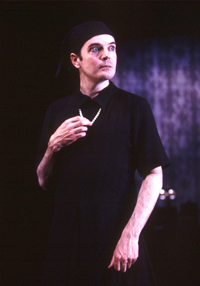 Artifact
as Survivor
Artifact
as Survivor
By Alexis Greene
I Am My Own Wife
By Doug Wright
Playwrights Horizons
416 W. 42nd St.
Box office: (212) 279-4200
The dark eyes of Jefferson Mays glitter
ferociously as he stands on the main stage at Playwrights’ Horizons.
Costumed in a black peasant dress adorned only with a string of
pearls, he portrays a German transvestite named Charlotte von
Mahlsdorf in Doug Wright’s new play I Am My Own Wife.
Looking at the audience, seeing us see the mesmerizing combination
of graceful actor and piercing expression, Mays challenges us,
if we can, to uncover the secrets of Charlotte’s private world.
This daring, imaginative performance is
the main reason to see Wright’s play, which tries desperately
but unsatisfactorily to reveal a fascinating character to us and
to himself, and to find a metaphor for survival in her unique
story.
Wright, who is probably best known as the
author of Quills, a drama about the Marquis de Sade,
first met Charlotte in 1992, when she was 65 and still living
in Germany, and interviewed her and corresponded with her until
she died in 2002. When Lothar Berfelde was in his early teens,
Wright learned, a cross-dressing aunt helped the boy discover
his true sexual orientation, and Charlotte, a woman with jaw-length
blonde hair and massive hands, emerged. At the age of sixteen,
according to the play, she murdered her abusive Nazi father, who
she believed would have killed her and her mother. Jailed for
the crime, she claims to have escaped when the Russians attacked
Berlin toward the end of World War II and eventually she moved
into a crumbling mansion. There she started collecting Victrolas
and gramophones, late-nineteenth-century clocks and furniture,
which the play suggests she cherished more than human beings.
The Berlin wall went up, and Charlotte
lived in East Berlin in her furniture museum, running a tavern
for gay men and women in the basement and keeping the secret police
at bay, probably by informing on fellow collectors. When will
you marry, her mother asked when Charlotte was around 40. “I am
my own wife,” Charlotte told her.
On stage this story unfolds like a documentary.
It is an amalgam of excerpts from Wright’s taped interviews, recreations
of his own process of self-doubt and partial discovery, and cameos
of people in both Charlotte’s world and his own. Mays acts Charlotte
and at least 40 other characters, almost always wearing the black
dress and pearls but seamlessly changing accents, physical postures
and outlooks. By turns he plays the gentle aunt; an angry jailed
friend who does not know that Charlotte has betrayed him to the
police; an asinine television talk-show host; and most importantly
Doug Wright, anxious, caring interviewer and dramatist. Editor
as much as playwright, Wright constructs a piece that cuts back
and forth between Charlotte and the people she encounters, including
himself, sitting in her museum and recording her words on tape.
The elegant production lends the play the
freedom it needs. Upstage, scenic designer Derek McLane provides
a high wall of shelves stuffed with clocks, tables and vintage
record players, lit by David Lander so that the objects glow with
a sort of burnished shine.
Downstage, the director Moisés Kaufman
puts only an occasional wooden table or cabinet, on which Charlotte
sets a Victrola or, in the production’s artful approach to offering
a tour of her museum, miniature pieces of furniture. Unfortunately
Kaufman paces every sequence similarly, so that the production
feels without rhythmic variation.
But exquisite though the production looks,
and riveting though Mays is, something is lacking in the play.
It is as if Wright became so enveloped by his research that he
lost his way. In an interview with Playwrights artistic director
Tim Sanford, Wright describes how “the more I discovered about
my central character, the more conflicted I became about her very
nature. And it became harder and harder and harder to write.”
Five years after he began to interview Charlotte, he felt blocked
and had not found a dramatic form for his passion.
Ultimately, working with Kaufman and Mays,
Wright evolved the play’s current shape. But sitting in the theatre,
we yearn for more scenes depicting this unique woman, and fewer
showing the writer, no matter how adeptly Mays transforms from
one to the other. While breaking through his own creative wall,
Wright constructs a barrier of interviews and facts between us
and his subject.
Perhaps the barrier is a natural outcome
of the playwright’s frustration. As the character of Wright admits
more than once, he never penetrates to the heart of the intriguing
Charlotte. Never learns what beats beneath the pearls and the
black dress. Nor do we. What was her sexual life? Did she even
have one? According to a 1992 German documentary, she did, but
for some reason Wright excises this vital side of Charlotte’s
personality.
Except for a few moments, largely created
through the gleaming eyes and open face of the extraordinary Mays,
we rarely glimpse this woman’s soul. One glimpse comes when the
teen-age Charlotte, dressing in her aunt’s clothes, first looks
at herself in a mirror, and we see an instant of recognition and
pleasure. Another happens when she describes killing her brutal
father.
But mostly, as Wright voices toward the
play’s end, Charlotte is like a piece of her beloved collection.
“I became this furniture,” she says at one point. In this identification
Wright finds a symbol and an answer to how Charlotte survived
two murderous political regimes. To us she remains a curiosity--fascinating,
but veiled and not quite human.
